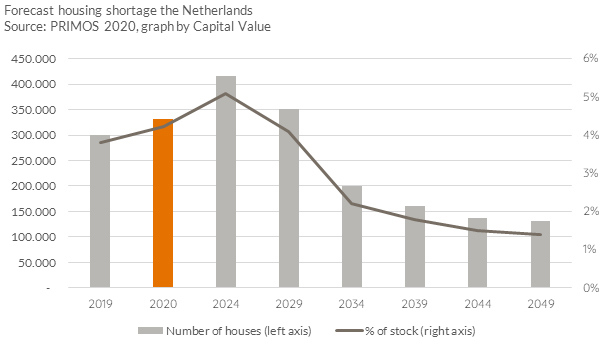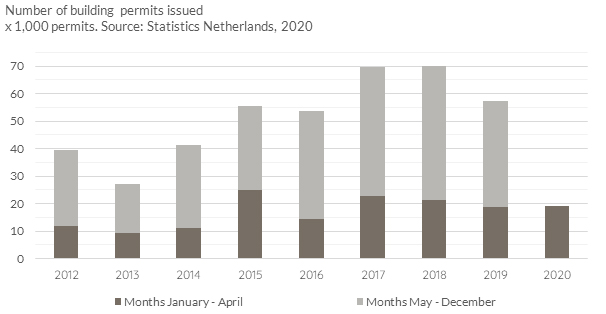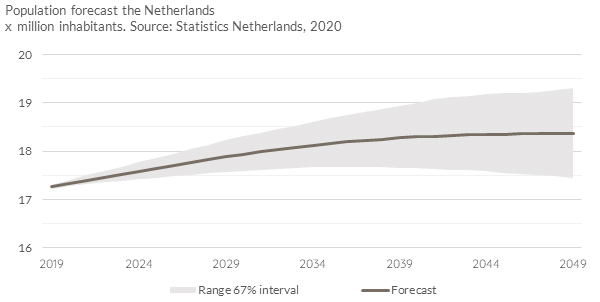Housing shortage in the Netherlands will rise to 415,000 homes in 2024
17 juni 2020
The housing shortage in the Netherlands is greater than had recently been estimated and will continue to increase in the coming years. According to the latest estimates (Primos, 2020), the housing shortage will reach a peak of 415,000 homes in 2024. This is approximately 100,000 homes more than at the end of 2019 and makes up a total of 5.1% of the housing stock. The current housing shortage has now been estimated to be around 331,000 homes as was recently published in the Dutch government's 'The State of the Housing Market'. This is approximately 15,000 more homes than in the prognosis from Capital Value's research report released earlier this year. The increase in the housing shortage is caused partially by an output of new homes that is currently too low. During the first four months of 2020, approximately 19,000 building permits were issued. The total prognosis for 2020 is calculated to be 55,000, while 85,000 to 100,000 homes annually are required to effectively lower the housing shortage.
Housing shortage from 315,000 in February to 415,000 in 2024
The housing shortage will increase in the next few years. Whereas at the beginning of this year a shortage of 315,000 homes was calculated with a possible increase of 360,000 to 380,000 homes in 2022 (Capital Value, 2020), the latest Primos' estimates have shown that the housing shortage is increasing at a higher rate than had previously been calculated. The housing shortage is currently around 331,000 homes and will rise to 415,000 by 2024. To address the shortage and meet future demand, 845,000 homes must be built in the next 10 years according to 'The State of the Housing Market' by the Ministry of the Interior and Kingdom Relations.
Number of building permits issued remains insufficient
Recent figures from Statistics Netherlands indicate that the number of building permits issued in the first four months of 2020 is equal to the number issued in the first four months of 2019: nearly 19,000 permits. In 2019, the issuance of permits was restricted by the nitrogen pollution and PFAS crises and by capacity issues. The total number of permits issued amounted to approximately 57,000. This is not enough to effectively address the shortage. The issuing of permits will also probably be delayed even more because of the corona crisis: municipal offices and the Council of State were closed for a period of time for new applications and appellate hearings due to the lockdown. Fewer permits were possibly applied for, too, because new developments with expensive owner-occupied homes were more difficult to finance. The EIB estimated earlier this year that the number of building permits would be around 48,000 in 2020. New figures through the month of April could indicate that this number might be slightly higher over the whole of 2020. If the current rate of granting permits is maintained, then a total number of approximately 55,000 to 60,000 could possibly be reached. This is still much lower than the 85,000 to 100,000 permits that are required annually

Population prognosis and growth in the number of households have a significant influence on housing shortage estimates
The expected population growth and the growth in the number of households combined determine the future demand for housing. Since the expected population growth is partially based on an anticipated positive migration rate, this has become less certain in the short term. Migrating to the Netherlands has (temporarily) become more difficult due to the corona crisis, causing a city such as Amsterdam to expect a stagnation in population growth because of a decreasing number of expats arriving.
Looking further into the future, the anticipated population growth is always associated with a certain degree of uncertainty. For this reason, Statistics Netherlands always creates intervals in which the expected growth will occur. The population number in the Netherlands is between 17.2 and 19.7 million inhabitants with 67% certainty according to the most recent prognosis. The fact that this estimate does not provide 100% certainty, and that there is clearly a range (see figure), shows that the anticipated housing shortage can always be adjusted either up or down in the future based on the actual population growth. The population grew faster than expected in 2019 which caused the housing shortage to increase even more. Additional growth in the number of households is also anticipated in the coming years.

Investors and housing associations want to invest more in the construction of new residential rental homes
In a recent survey conducted by Capital Value, 89% of housing associations indicated a willingness to continue to invest in new-build projects during the crisis. This has been confirmed by the publication of The Renewed City, a collaboration between 27 large municipal housing associations that collectively want to invest 23.4 billion euros in the sustainable renovation and construction of rental homes over the next five years. Dutch and foreign pension funds also want to invest more in the construction of affordable rental homes in the near future.
Marijn Snijders, Director Capital Value, adds "It is important that the government intensifies the granting of building permits as soon as possible in order to address the increasing shortages. Opportunities are there especially now. Housing associations and investors have a willingness to continue to invest in additional rental homes and construction companies and developers have sufficient capacity, too. Alternative financing constructions must be realised for long-term investments since parties are hesitant to invest risk capital in land positions. Extending government incentives for sustainable renovations for the construction of social housing can also provide an important incentive."


